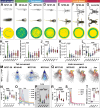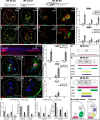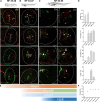This is a preprint.
Spinal neuron diversity scales exponentially with swim-to-limb transformation during frog metamorphosis
- PMID: 39345366
- PMCID: PMC11430061
- DOI: 10.1101/2024.09.20.614050
Spinal neuron diversity scales exponentially with swim-to-limb transformation during frog metamorphosis
Abstract
Vertebrates exhibit a wide range of motor behaviors, ranging from swimming to complex limb-based movements. Here we take advantage of frog metamorphosis, which captures a swim-to-limb-based movement transformation during the development of a single organism, to explore changes in the underlying spinal circuits. We find that the tadpole spinal cord contains small and largely homogeneous populations of motor neurons (MNs) and V1 interneurons (V1s) at early escape swimming stages. These neuronal populations only modestly increase in number and subtype heterogeneity with the emergence of free swimming. In contrast, during frog metamorphosis and the emergence of limb movement, there is a dramatic expansion of MN and V1 interneuron number and transcriptional heterogeneity, culminating in cohorts of neurons that exhibit striking molecular similarity to mammalian motor circuits. CRISPR/Cas9-mediated gene disruption of the limb MN and V1 determinants FoxP1 and Engrailed-1, respectively, results in severe but selective deficits in tail and limb function. Our work thus demonstrates that neural diversity scales exponentially with increasing behavioral complexity and illustrates striking evolutionary conservation in the molecular organization and function of motor circuits across species.
Keywords: conservation; diversity; interneuron; locomotion; motor neurons.
Conflict of interest statement
DECLARATION OF INTERESTS We declare no competing interests.
Figures








Similar articles
-
Spinal V1 inhibitory interneuron clades differ in birthdate, projections to motoneurons, and heterogeneity.bioRxiv [Preprint]. 2024 Sep 17:2023.11.29.569270. doi: 10.1101/2023.11.29.569270. bioRxiv. 2024. Update in: Elife. 2024 Nov 28;13:RP95172. doi: 10.7554/eLife.95172. PMID: 38076820 Free PMC article. Updated. Preprint.
-
Partly shared spinal cord networks for locomotion and scratching.Integr Comp Biol. 2011 Dec;51(6):890-902. doi: 10.1093/icb/icr041. Epub 2011 Jun 22. Integr Comp Biol. 2011. PMID: 21700568
-
Modeling spinal locomotor circuits for movements in developing zebrafish.Elife. 2021 Sep 2;10:e67453. doi: 10.7554/eLife.67453. Elife. 2021. PMID: 34473059 Free PMC article.
-
Spinal cords: Symphonies of interneurons across species.Front Neural Circuits. 2023 Apr 26;17:1146449. doi: 10.3389/fncir.2023.1146449. eCollection 2023. Front Neural Circuits. 2023. PMID: 37180760 Free PMC article. Review.
-
Central circuits controlling locomotion in young frog tadpoles.Ann N Y Acad Sci. 1998 Nov 16;860:19-34. doi: 10.1111/j.1749-6632.1998.tb09036.x. Ann N Y Acad Sci. 1998. PMID: 9928299 Review.
References
-
- Biewener A., and Patek S. (2018). Animal Locomotion (Oxford University Press; ).
Publication types
Grants and funding
LinkOut - more resources
Full Text Sources
